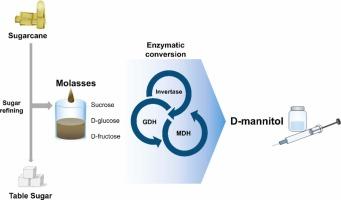Upcycling agro-industrial biomass molasses into D-mannitol via an enzymatic cascade with in situ cofactor regeneration
IF 6.2
1区 农林科学
Q1 AGRICULTURAL ENGINEERING
引用次数: 0
Abstract
Molasses, a sugar industry by-product rich in sucrose, D-glucose, and D-fructose, remains underutilized in high-value biomanufacturing. In this study, we present an efficient enzymatic cascade for the direct conversion of molasses into D-mannitol, a valuable sugar alcohol widely used in the food and pharmaceutical sectors. The cascade integrates three enzymes: invertase for sucrose hydrolysis, mannitol dehydrogenase (MDH) for D-fructose reduction, and glucose dehydrogenase (GDH) for in situ NADH regeneration via D-glucose oxidation, which simultaneously generates D-gluconolactone as a value-added coproduct. Two reaction formats were evaluated: a two-step system that sequentially optimizes enzyme-specific conditions, and a one-pot system enabling operational simplicity. The two-step method yielded 137 ± 13 mM D-mannitol, corresponding to ∼92 % conversion, while the one-pot system produced 123.1 ± 1.3 mM, corresponding to ∼95 % conversion under molasses conditions within 24 h. The molasses pretreatment was not essential for D-mannitol production. Enzymes maintained high catalytic activity in the complex molasses matrix, and glucose supplementation improved cofactor regeneration, eliminating residual D-fructose. This integrated strategy offers a sustainable and scalable platform for agro-industrial waste valorization by co-producing D-mannitol and D-gluconolactone, aligning with circular bioeconomy principles and advancing green bioprocessing technologies.

通过酶联级联和原位辅助因子再生,将农业-工业生物质糖蜜升级为d -甘露醇
糖蜜是一种富含蔗糖、d -葡萄糖和d -果糖的制糖业副产品,在高价值生物制造中仍未得到充分利用。在这项研究中,我们提出了一种有效的酶级联反应,将糖蜜直接转化为d -甘露醇,这是一种广泛应用于食品和制药行业的有价值的糖醇。该级联包含三种酶:蔗糖水解转化酶,d -果糖还原甘露醇脱氢酶(MDH)和葡萄糖脱氢酶(GDH),通过d -葡萄糖氧化原位再生NADH,同时生成d -葡萄糖内酯作为增值副产物。评估了两种反应形式:两步系统依次优化酶特异性条件,一锅系统使操作简单。两步方法取得了137年 ± D-mannitol 13毫米,对应∼92 %转换,而锅系统产生123.1 ±1.3 mM,对应∼95 %转换在24 h 糖蜜的条件下。糖蜜预处理对d -甘露醇的生产并不是必需的。酶在复合糖蜜基质中保持较高的催化活性,葡萄糖的补充促进了辅助因子的再生,消除了残留的d -果糖。这一综合战略通过联合生产d -甘露醇和d -葡萄糖酸内酯,为农业工业废物增值提供了一个可持续和可扩展的平台,符合循环生物经济原则,推进绿色生物处理技术。
本文章由计算机程序翻译,如有差异,请以英文原文为准。
求助全文
约1分钟内获得全文
求助全文
来源期刊

Industrial Crops and Products
农林科学-农业工程
CiteScore
9.50
自引率
8.50%
发文量
1518
审稿时长
43 days
期刊介绍:
Industrial Crops and Products is an International Journal publishing academic and industrial research on industrial (defined as non-food/non-feed) crops and products. Papers concern both crop-oriented and bio-based materials from crops-oriented research, and should be of interest to an international audience, hypothesis driven, and where comparisons are made statistics performed.
 求助内容:
求助内容: 应助结果提醒方式:
应助结果提醒方式:


